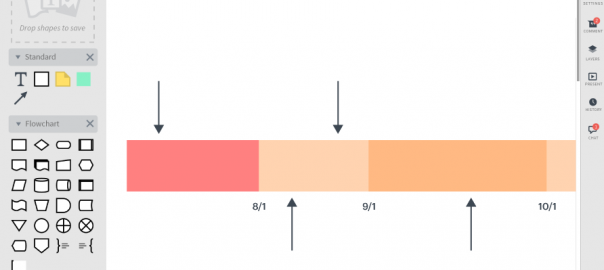— April 10, 2019

An effective project timeline is essential to ensuring that your project is transparent and efficient. At the end of the day, this can have a significant impact on the profitability of your work. Wondering how to create a project timeline? Here’s everything you need to know.
What is a Project Timeline (and why is it so important?)
Put simply, a project timeline tracks the chronological order of events. These timelines give teams an understanding of a project at just a glance, keeping everyone informed and aligned at every stage of the project.
The timeline is composed of a series of tasks, each of which has a due date and duration. The link between those tasks can also be created, helping to reveal dependencies and preempt any potential blockers.
An accurate project timeline is critical. It shapes the entire project, indicating which tasks are to be completed at which stage and which significant milestones need to be met along the way.
Project managers need to develop their abilities when it comes to creating a successful project timeline. They should understand the data that they need, how it should be visualized, and the tool that will be used to share this with the rest of the team.
Another critical ability is the maintenance and management of the project timeline once it has been created.
A successful project timeline helps to maintain a productive and engaged team who work together toward a common goal to seize success. A poor timeline, on the other hand, can lead to confusion, missed deadlines, wasted costs, and unhappy clients.
How to Create a Project Timeline (Step by Step)
Now that we have a better understanding of what is at stake, let’s take a closer look at how to make a project timeline. This is everything that you need to know to make your own project timeline.
1. Understand the scope of your project
As a marketing project manager, your project will begin with a brief. To make sure that your project timeline flourishes healthily, you need to take good care of these foundations.
You need to develop a clear understanding of the brief and everything that is required. This can take some time and require close consultation with your client. It is critical, though, that the project scope is as accurate and detailed as possible.
You should produce a project scope statement that everyone understands. This will be a statement that succinctly and accurately sums up the goal of the project. For example:
“Our team will design, develop, and populate a new blog on the website of our client.”
2. Begin breaking the project down into smaller pieces
Now that you have an idea of the big picture, it’s time to zoom in and see which smaller pieces actually make up that large statement.
In our example, the marketing project manager is going to coordinate the design, development and content of a new blog. There are a lot of moving pieces here and a lot of constituent parts. The project will require, for example, the following parts:
- A theme for the blog
- Visual guidelines
- Tone of voice guidelines
- A content plan
- Content for the blog
This will always vary according to the project scope statement that you defined, but it’s important that you think about every sub-deliverable that you will need to provide to deliver the whole.
3. Explore those pieces to create tasks
Now that you have your sub-deliverables, it’s time to dig deeper. Let’s take the theme, for example. Your team will have to complete the following work to create that sub-deliverable:
- Conduct competitor research
- Brainstorming and feasibility testing
- UI & UX attention
- Design of wireframes
- Development of the theme
- Quality testing
Of course, this might vary according to the specifications of the project. But this gives you an idea of how you need to start thinking about the constituent tasks that make up the sub-deliverables. This will give you a good look at the iceberg resting beneath the surface, helping you to plan accurately in the following steps.
4. Think about dependencies
Some tasks cannot begin until others have been completed. The design of the wireframes, for example, might not be able to take place until a key section of the visual guidelines has been created.
These dependencies mean that your project has a definite natural order. Depending on the complexity of your project, though, this can become quite a headache. (There are some tools that can help, though, and we will look at those soon.)
Once you have organized which tasks need to come first, you will find that your timeline is beginning to adopt a more conventional shape.
5. Calculate the time required for each task
The tasks are now in a nice neat order, but how far apart do they need to be?
You need to call upon your marketing experience to create accurate estimations for each of the tasks in your project. You might find, for example, that you need to allow three weeks for the development of the wireframes but just a few days for quality testing.
As you space out the tasks on a horizontal line, you will begin to see that you naturally develop an estimation for how long a project might take. Creating accurate estimations is no easy task, and many marketing project managers consult with a range of professionals to get a better idea.
6. Assess your resources
Now that you know what you need and how long it will take, it’s time to fill in the gaps. The best marketing project managers are eventually able to take the abilities and preferences of their team into account. This can help to create more accurate timelines.
Balancing responsibilities is tough. Even though a given task might take four hours, for example, unexpected occurrences can derail the process and this can have an impact on other areas of the project.
Project management demands that you think on your feet and make the best of the project management tools that are available to you.
7. Outline important milestones
Your project timeline is almost there, but now you need to think about tracking the progress of the project at regular intervals. This is a very important step, given that it means your team can get the feedback and approval they need far before the final deadline.
This means that if necessary, you can take the initiative to adjust plans to ensure that everything stays on track. Milestones should be placed regularly and based around certain key moments, like the completion of a large task.
8. Choose the correct software to build your timeline
You have planned out your timeline, but now it’s a question of actually putting it together in a way that is logical, accessible, and adaptable. Until now, this was easier said than done. But there are many quality project management applications available to you now.
Project Timeline Software
You will find that there are many project timeline software options on the market. Here is a closer look at the key options that might fit your project management needs.
Monday
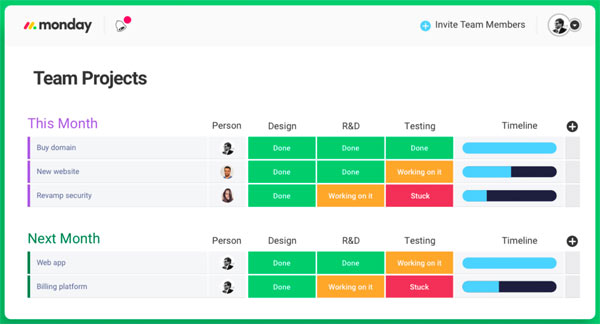
Monday is a visual tool that makes it possible for marketing project managers to plan, organize, and track their team’s projects. The platform prides itself on easy onboarding and fast adoption, offering six views to help teams keep up with plans and adjust for the future.
“Since our projects bring teams from various departments, it’s great to have a central place to communicate and collaborate. Monday.com has tremendous potential but we also find some challenges with it including sub-tasks, notifications, and the pricing.”
Teamwork Projects
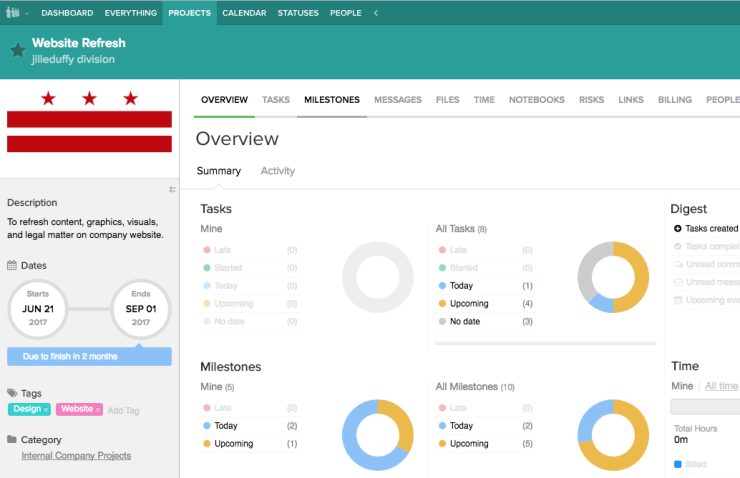
This is a cloud-based project management solution that helps businesses and project managers to manage the various parts of a project to control objectives and businesses processes. The features include task lists, time tracking, and more.
“It’s awesome how the projects and tasks are set up and all the actions you can take on them to keep things logged and up to date and organized. I do wish there was a calendar view of all the tasks assigned to you so you could see the density on how stuff is assigned and when so it’s easier to work ahead.”
ProjectManager.com
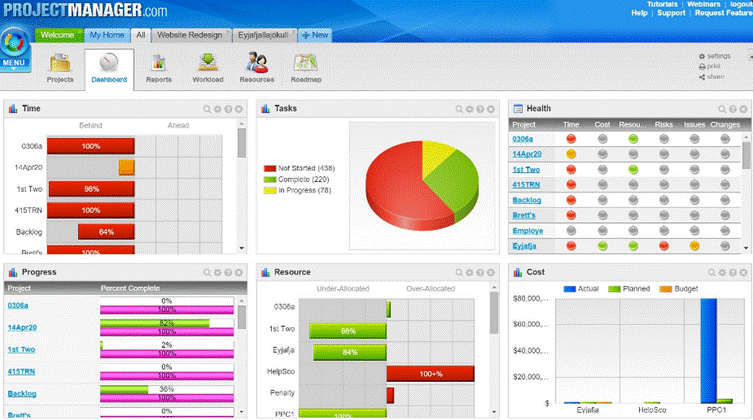
ProjectManager is designed to help teams plan, track, and collaborate online. A range of real-time dashboards helps to demonstrate the progress that has been made on projects and what is next.
“ProjectManager.com is very easy to use. We were able to get up and running in a very short amount of time and now we have approximately 300 projects that we are managing and about 70 resources. There are a few features that do not work as well as I would like but I am hoping they will be updated in the near future.”
Workzone
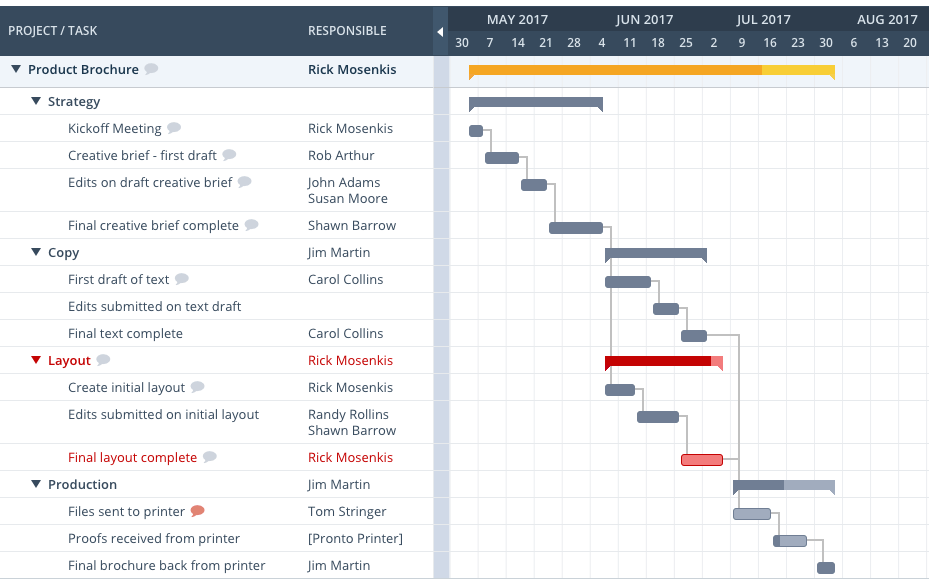
Workzone describes itself as being robust and powerful yet simple to use. The tool helps project managers to track progress and team members, while also measuring and improving results.
“The system provides a great high-level status view, with the ability to drill down into specifics. Navigation through the system could be improved in some areas, such as returning to where you were on a page after making a change, as opposed to a full page refresh.”
TeamGantt
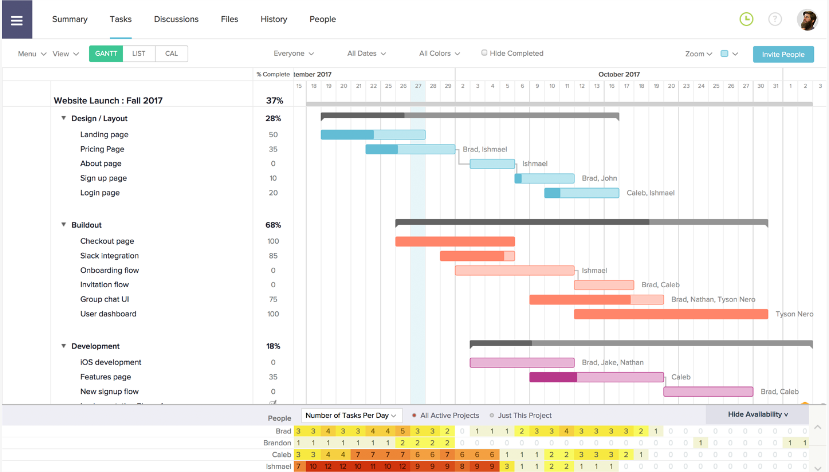
This piece of online project management software aims to help marketing project managers plan their projects in mere minutes using Gantt charts. TeamGantt aims to make the creation of these charts simple to make project scheduling and management a breeze.
“Once you start setting up your projects, you find that it has highly advanced features and can scale heavily to meet larger requirement sets. There are small issues with usability, which feel largely rooted in the fact that the system runs in a web browser.”
5 Project Timeline Templates
Interesting in exploring a range of alternative options? Here is a closer look at five additional project timeline templates.
Gantt Chart Excel Template by TeamGantt
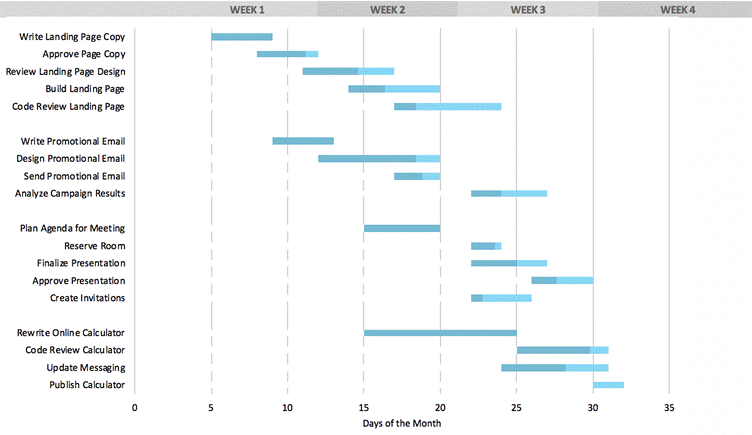
TeamGantt was kind enough to put together a free Gantt chart Excel template for project managers. The tool can save project managers a lot of time and remove many tedious planning tasks that become a chore to complete. The tool can be downloaded for free and it is compatible with Excel versions 200 and up on both Mac and Windows.
Project Timeline Template by Bitrix24
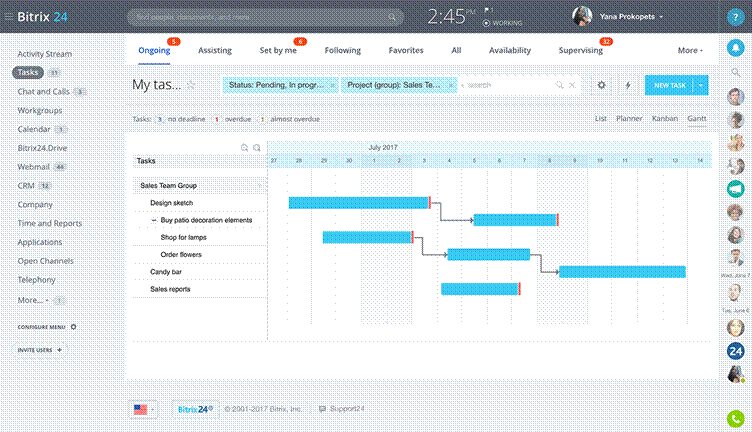
Bitrix24 is a free project management solution that comes equipped with some preloaded project timeline templates. This timeline view can help project managers to make the most of a Gantt chart to see their projects in a new way. Dependencies are also covered, meaning that once one task has been adjusted, this will be reflected throughout the project.
Project Management Timeline Template by Lucidchart
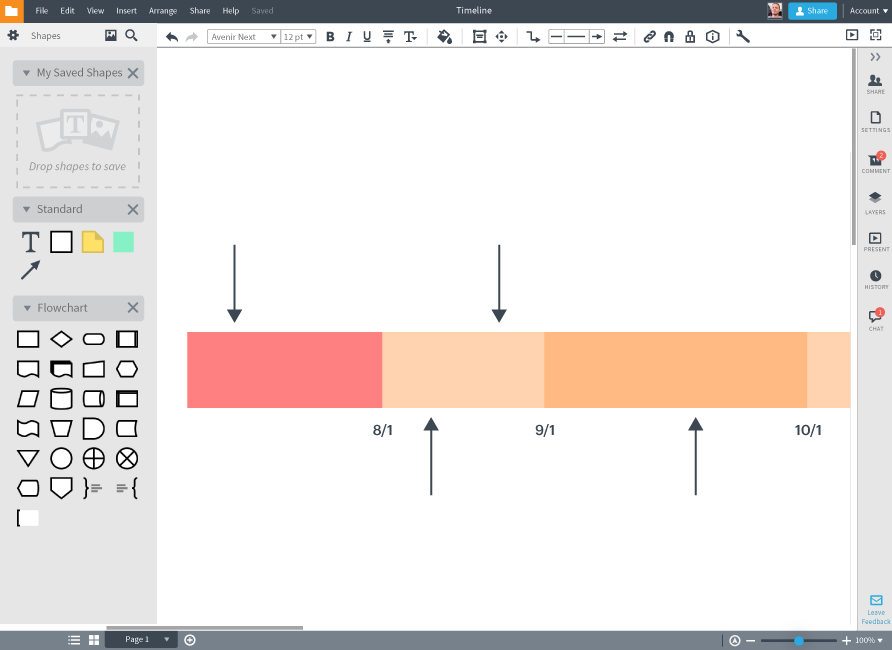
At the end of this article, Lucidchart offers a variety of project management timeline templates through its platform. Marketing project managers are able to login to the platform to access the templates, which are intended to help with managing multiple teams, large projects, and those projects with a range of milestones.
Project Timeline Template by HubSpot
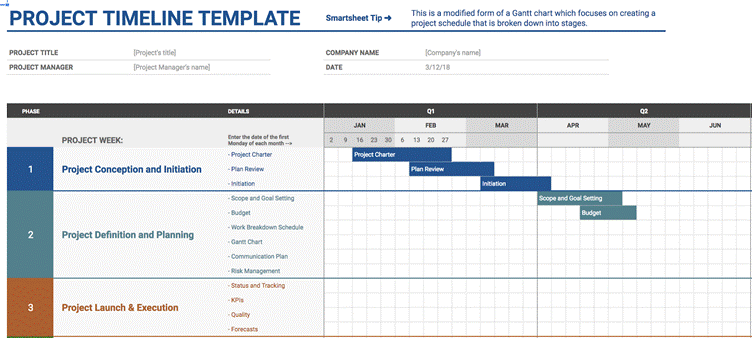
When used effectively, Google Sheets has the potential to be a project management powerhouse (along with the rest of the G Suite), and the Sheets app can be used to create project timelines. HubSpot has kindly curated a list of the best Google Sheets templates. These are free and available to marketing project managers.
Project Timeline Template by My Product Roadmap
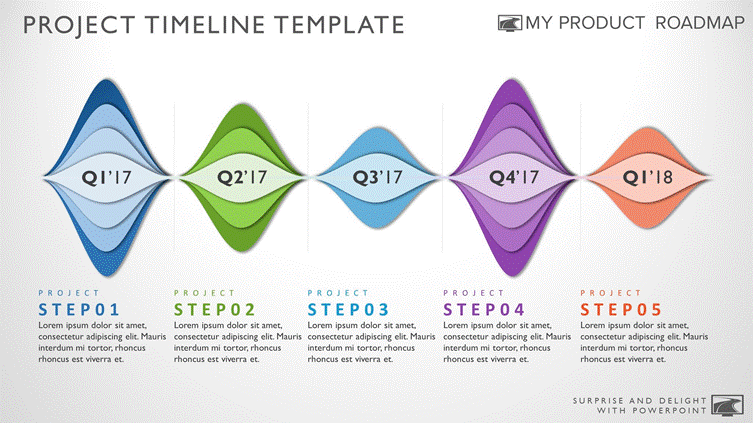
If you are looking to impress with a beautiful and descriptive project timeline template, then you might want to consider using this project timeline template for PowerPoint that was kindly provided by My Product Roadmap. Project managers are free to add and edit their information, creating a project timeline that is catered to their company.
3 Project Timeline Examples
Looking for some serious inspiration? Here is a closer look at some of the best project timeline examples.
Marketing Project Timeline by Template.net
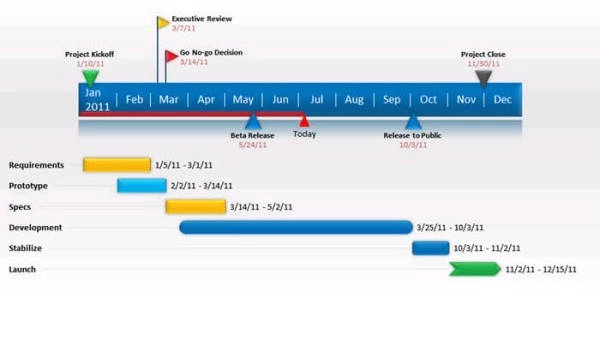
Template.net understands that planning a large project can become difficult very quickly. It has put together 23 of the best project timeline examples to help you feel inspired. Using this resource, you will be able to learn from established best practice and think more deeply about which option is going to be the most effective for your particular needs.
Not only is this useful from a practical perspective, but it can also help you to deepen your understanding of project timelines, what they are for, and what they can achieve.
Project Sprint Timeline Example by Venngage (#2)
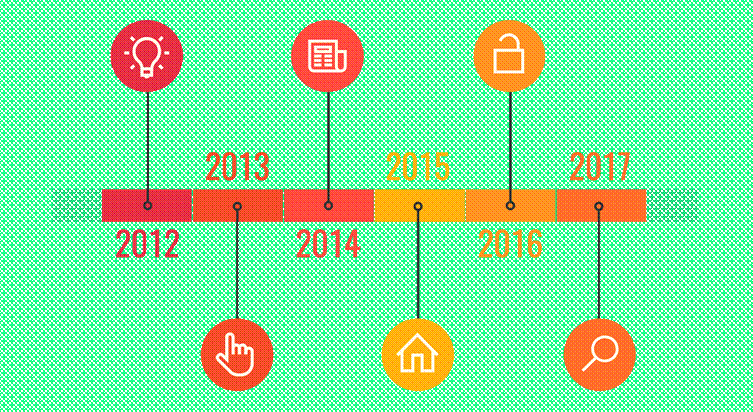
If you are particularly concerned about the aesthetics of your project timeline, then this collection of project timeline best practice will help you to put together a creative and visually-engaging timeline that will delight your team.
This isn’t just about aesthetics, of course: there are great practical reasons to put a lot of effort into the design of your project timeline. You can also pick up some tricks on how to make your project timeline a document that is pleasant to look at and supports your brand.
Project Timeline Example by Realtimeboard
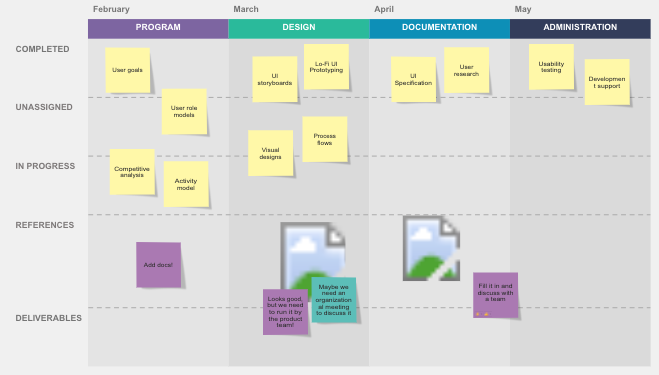
This is an effective project timeline template that values simplicity. It can be used by project managers to create descriptive and clear project timelines that inspire the team. To access the tool, though, you will have to create an account. If you are looking for a simple tool, it could be worth investigating in more depth.
Conclusion
An effective project timeline is absolutely essential to the success of your project. We hope that this post has helped you to see the value of a great project timeline, and equipped you with the knowledge and tools to put one together for your project!
Business & Finance Articles on Business 2 Community
(152)
Report Post